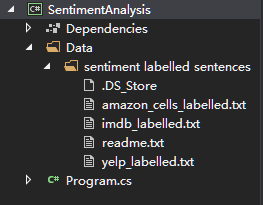在发出《.NET Core玩转机器学习》和《使用ML.NET预测纽约出租车费》两文后,相信读者朋友们即使在不明就里的情况下,也能按照内容顺利跑完代码运行出结果,对使用.NET Core和ML.NET,以及机器学习的效果有了初步感知。得到这些体验后,那么就需要回头小结一下了,本文仍然基于一个情感分析的案例,以刚接触机器学习的.NET开发者的视角,侧重展开一下起手ML.NET的基本理解和步骤。
当我们意识到某个现实问题超出了传统的模式匹配能力范围,需要借助模拟的方式先尽可能还原已经产生的事实(通常也称为拟合),然后复用这种稳定的模拟过程(通常也称为模型),对即将发生的条件进行估计,求得发生或不发生相同结果的概率,此时就是利用机器学习最好的机会,同时也要看到,这也是机器学习通常离不开大量数据的原因,历史数据太少,模拟还原这个过程效果就会差很多,自然地,评估的结果误差就大了。所以在重视数据的准确性、完整性的同时,要学会经营数据的体量出来。
若要使用机器学习解决问题,一般会经历以下这些步骤:
1. 描述问题产生的场景
2. 针对特定场景收集数据
3. 对数据预处理
4. 确定模型(算法)进行训练
5. 对训练好的模型进行验证和调优
6. 使用模型进行预测分析
接下来我将用案例逐一介绍。
描述问题产生的场景
说到情感分析,我假定一个最简单的句子表达的场景,就是当看到一句话,通过特定的词语,我们能判断这是一个正向积极的态度,或是负面消极的。比如“我的程序顺利通过测试啦”这就是一个正向的,而“这个函数的性能实在堪忧”就是一个负面的表达。所以,对词语的鉴别就能间接知道说这句话的人的情感反应。(本案例为降低理解的复杂程度,暂不考虑断句、重音、标点之类的这些因素。)
针对特定场景收集数据
为了证实上面的思路,我们需要先收集一些有用的数据。其实这也是让众多开发者卡住的环节,除了使用爬虫和自己系统中的历史数据,往往想不到短时间还能在哪获取到。互联网上有不少学院和机构,甚至政府都是有开放数据集提供的,推荐两处获取比较高质量数据集的来源:
UC Irvine Machine Learning Repository来自加州大学
kaggle.com一个著名的计算科学与机器学习竞赛网站
这次我从UCI找到一个刚好只是每行有一个句子加一个标签,并且标签已标注好每个句子是正向还是负向的数据集了。在Sentiment Labelled Sentences Data Set下载。格式类似如下:
A very, very, very slow-moving, aimless movie about a distressed, drifting young man. 0 Not sure who was more lost - the flat characters or the audience, nearly half of whom walked out. 0 Attempting artiness with black & white and clever camera angles, the movie disappointed - became even more ridiculous - as the acting was poor and the plot and lines almost non-existent. 0 Very little music or anything to speak of. 0 The best scene in the movie was when Gerardo is trying to find a song that keeps running through his head. 1 The rest of the movie lacks art, charm, meaning... If it's about emptiness, it works I guess because it's empty. 0 Wasted two hours. 0 ...
观察每一行,一共是Tab分隔的两个字段,第一个字段是句子,一般我们称之为特征(Feature),第二个字段是个数值,0表示负向,1表示正向,一般我们称之为目标或标签(Label),目标值往往是人工标注的,如果没有这个,是无法使用对历史数据进行拟合这种机器学习方式的。所以,一份高质量的数据集对人工标注的要求很高,要尽可能准确。
对数据预处理
对于创建项目一系列步骤,参看我开头提到的两篇文章即可,不再赘述。我们直接进入正题,ML.NET对数据的处理以及后面的训练流程是通用的,这也是为了以后扩展到其他第三方机器学习包设计的。首先观察数据集的格式,创建与数据集一致的结构,方便导入过程。LearningPipeline类专门用来定义机器学习过程的对象,所以紧接着我们需要创建它。代码如下:
const string _dataPath = @".datasentiment labelled sentencesimdb_labelled.txt"; const string _testDataPath = @".datasentiment labelled sentencesyelp_labelled.txt"; public class SentimentData { [Column(ordinal: "0")] public string SentimentText; [Column(ordinal: "1", name: "Label")] public float Sentiment; } var pipeline = new LearningPipeline(); pipeline.Add(new TextLoader<SentimentData>(_dataPath, useHeader: false, separator: "tab")); pipeline.Add(new TextFeaturizer("Features", "SentimentText"));
SentimentData就是我需要的导入用的数据结构,可以看到,Column属性除了指示对应数据集的行位置,额外的对应最后一列,表示正向还是负向的字段,还要指定它是目标值,并取了个标识名。TextLoader就是专门用来导入文本数据的类,TextFeaturizer就是指定特征的类,因为每一行数据不是每一个字段都可以成为特征的,如果有较多字段时,可以在此处特别地指定出来,这样不会被无关的字段影响。
确定模型(算法)进行训练
本案例目标是一个0/1的值类型,换句话说恰好是一个二分类问题,因此模型上我选择了FastTreeBinaryClassifier这个类,如果略有了解机器学习的朋友一定知道逻辑回归算法,与之在目的上大致相似。若要定义模型,同时要指定一个预测用的结构,这样模型就会按特定的结构输出模型的效果,一般这个输出用的结构至少要包含目标字段。代码片段如下:
public class SentimentPrediction { [ColumnName("PredictedLabel")] public bool Sentiment; } pipeline.Add(new FastTreeBinaryClassifier() { NumLeaves = 5, NumTrees = 5, MinDocumentsInLeafs = 2 }); PredictionModel<SentimentData, SentimentPrediction> model = pipeline.Train<SentimentData, SentimentPrediction>();
对训练好的模型进行验证和调优
在得到模型后,需要用测试数据集进行验证,看看拟合的效果是不是符合预期,BinaryClassificationEvaluator就是FastTreeBinaryClassifier对应的验证用的类,验证的结果用BinaryClassificationMetrics类保存。代码片段如下:
var testData = new TextLoader<SentimentData>(_testDataPath, useHeader: false, separator: "tab"); var evaluator = new BinaryClassificationEvaluator(); BinaryClassificationMetrics metrics = evaluator.Evaluate(model, testData); Console.WriteLine(); Console.WriteLine("PredictionModel quality metrics evaluation"); Console.WriteLine("------------------------------------------"); Console.WriteLine($"Accuracy: {metrics.Accuracy:P2}"); Console.WriteLine($"Auc: {metrics.Auc:P2}"); Console.WriteLine($"F1Score: {metrics.F1Score:P2}");
像Accuracy,Auc,F1Score都是一些常见的评价指标,包含了正确率、误差一类的得分,如果得分很低,就需要调整前一个步骤中定义模型时的参数值。详细的解释参考:Machine learning glossary
使用模型进行预测分析
训练好一个称心如意的模型后,就可以正式使用了。本质上就是再取来一些没有人工标注结果的数据,让模型进行分析返回一个符合某目标值的概率。代码片段如下:
IEnumerable<SentimentData> sentiments = new[] { new SentimentData { SentimentText = "Contoso's 11 is a wonderful experience", Sentiment = 0 }, new SentimentData { SentimentText = "The acting in this movie is very bad", Sentiment = 0 }, new SentimentData { SentimentText = "Joe versus the Volcano Coffee Company is a great film.", Sentiment = 0 } }; IEnumerable<SentimentPrediction> predictions = model.Predict(sentiments); Console.WriteLine(); Console.WriteLine("Sentiment Predictions"); Console.WriteLine("---------------------"); var sentimentsAndPredictions = sentiments.Zip(predictions, (sentiment, prediction) => (sentiment, prediction)); foreach (var item in sentimentsAndPredictions) { Console.WriteLine($"Sentiment: {item.sentiment.SentimentText} | Prediction: {(item.prediction.Sentiment ? "Positive" : "Negative")}"); }
运行结果可以看到,其分类是符合真实判断的。尽管验证阶段的得分不高,这也是很正常的,再没有任何调优下,存在一些中性、多义的句子干扰预测导致的。

这样,再有新的句子就可以放心地通过程序自动完成分类了,是不是很简单!希望本文能带给.NET开发的朋友们对ML.NET跃跃欲试的兴趣。
顺便提一下,微软Azure还有一个机器学习的在线工作室,链接地址为:https://studio.azureml.net/,相关的AI项目库在:https://gallery.azure.ai/browse,对于暂时无法安装本地机器学习环境,以及找不到练手项目的朋友 ,不妨试试这个。
最后放出项目的文件结构以及完整的代码:

using System; using Microsoft.ML.Models; using Microsoft.ML.Runtime; using Microsoft.ML.Runtime.Api; using Microsoft.ML.Trainers; using Microsoft.ML.Transforms; using System.Collections.Generic; using System.Linq; using Microsoft.ML; namespace SentimentAnalysis { class Program { const string _dataPath = @".datasentiment labelled sentencesimdb_labelled.txt"; const string _testDataPath = @".datasentiment labelled sentencesyelp_labelled.txt"; public class SentimentData { [Column(ordinal: "0")] public string SentimentText; [Column(ordinal: "1", name: "Label")] public float Sentiment; } public class SentimentPrediction { [ColumnName("PredictedLabel")] public bool Sentiment; } public static PredictionModel<SentimentData, SentimentPrediction> Train() { var pipeline = new LearningPipeline(); pipeline.Add(new TextLoader<SentimentData>(_dataPath, useHeader: false, separator: "tab")); pipeline.Add(new TextFeaturizer("Features", "SentimentText")); pipeline.Add(new FastTreeBinaryClassifier() { NumLeaves = 5, NumTrees = 5, MinDocumentsInLeafs = 2 }); PredictionModel<SentimentData, SentimentPrediction> model = pipeline.Train<SentimentData, SentimentPrediction>(); return model; } public static void Evaluate(PredictionModel<SentimentData, SentimentPrediction> model) { var testData = new TextLoader<SentimentData>(_testDataPath, useHeader: false, separator: "tab"); var evaluator = new BinaryClassificationEvaluator(); BinaryClassificationMetrics metrics = evaluator.Evaluate(model, testData); Console.WriteLine(); Console.WriteLine("PredictionModel quality metrics evaluation"); Console.WriteLine("------------------------------------------"); Console.WriteLine($"Accuracy: {metrics.Accuracy:P2}"); Console.WriteLine($"Auc: {metrics.Auc:P2}"); Console.WriteLine($"F1Score: {metrics.F1Score:P2}"); } public static void Predict(PredictionModel<SentimentData, SentimentPrediction> model) { IEnumerable<SentimentData> sentiments = new[] { new SentimentData { SentimentText = "Contoso's 11 is a wonderful experience", Sentiment = 0 }, new SentimentData { SentimentText = "The acting in this movie is very bad", Sentiment = 0 }, new SentimentData { SentimentText = "Joe versus the Volcano Coffee Company is a great film.", Sentiment = 0 } }; IEnumerable<SentimentPrediction> predictions = model.Predict(sentiments); Console.WriteLine(); Console.WriteLine("Sentiment Predictions"); Console.WriteLine("---------------------"); var sentimentsAndPredictions = sentiments.Zip(predictions, (sentiment, prediction) => (sentiment, prediction)); foreach (var item in sentimentsAndPredictions) { Console.WriteLine($"Sentiment: {item.sentiment.SentimentText} | Prediction: {(item.prediction.Sentiment ? "Positive" : "Negative")}"); } Console.WriteLine(); } static void Main(string[] args) { var model = Train(); Evaluate(model); Predict(model); } } }